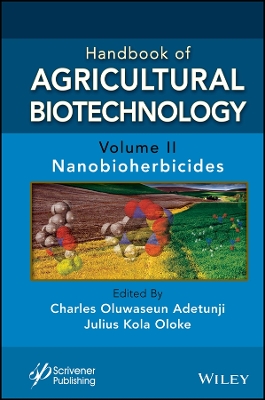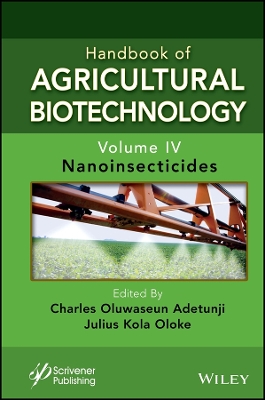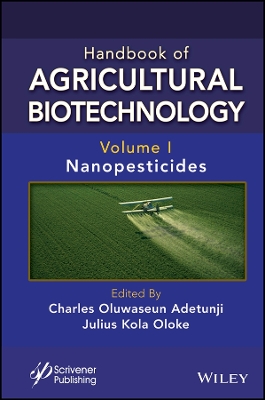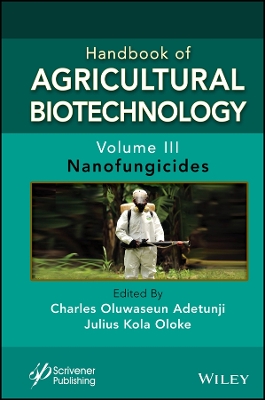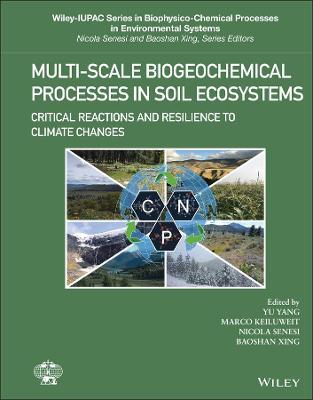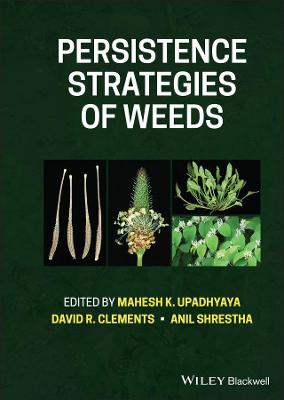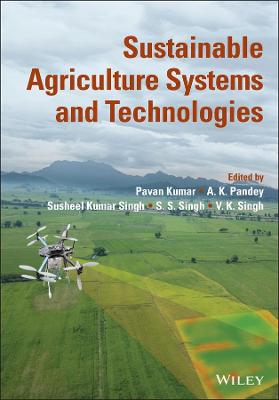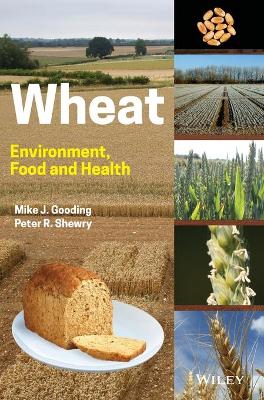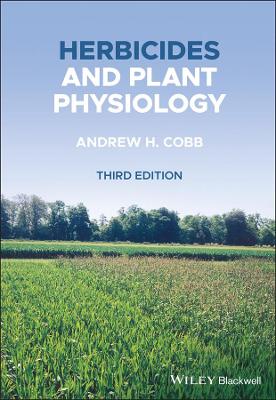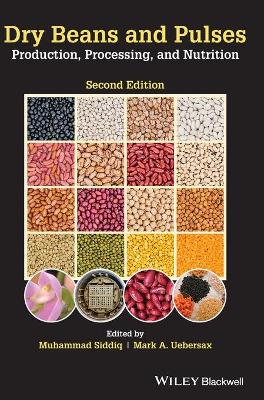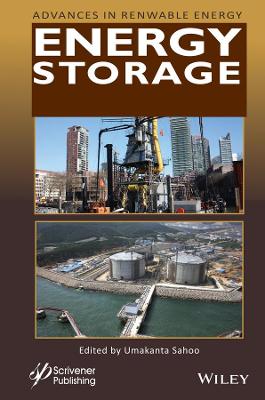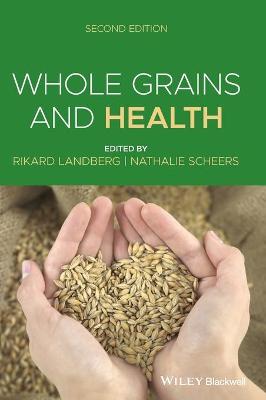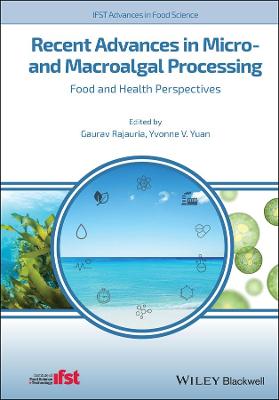Soil Chemistry
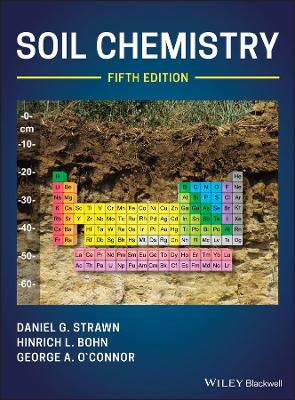 -15%
portes grátis
-15%
portes grátis
Soil Chemistry
Strawn, Daniel G.; Bohn, Hinrich L.; O'Connor, George A.
John Wiley and Sons Ltd
01/2020
384
Dura
Inglês
9781119515180
15 a 20 dias
1220
Preface to Fourth Edition xiii
Acknowledgments xiv
1 Introduction to Soil Chemistry 1
1.1 The soil chemistry discipline 1
1.2 Historical background 3
1.3 The soil environment 6
1.3.1 Soil chemical and biological interfaces 6
1.3.2 Soil solids 10
1.3.3 Soil interaction with the hydrosphere 11
1.3.4 Interaction of soil and the atmosphere 12
1.4 Chemical reactions in soils 15
1.4.1 Flow of chemical energy in soils 17
1.4.2 Soil chemical speciation 18
1.4.3 Chemical reaction types in soils 19
1.5 Soil biogeochemical cycling 22
1.6 Soil chemical influences on food production 22
1.7 Soils and environmental health 23
1.7.1 Soil chemistry and environmental toxicology 24
1.8 Units in soil chemistry 26
1.8.1 Converting units 26
1.9 Summary of important concepts in soil chemistry 26
Questions 29
Bibliography 29
2 Properties of Elements and Molecules 31
2.1 Introduction 31
2.2 Ionization and ionic charge 33
2.3 Ionic radius 33
2.4 Molecular bonds 36
2.5 Nature of water and hydration of ions 37
2.6 Ligands and metal bonds 40
2.7 Summary of important concepts of elemental and molecular properties 42
Questions 42
Bibliography 42
3 Characteristics of Chemicals in Soils 43
3.1 Introduction 43
3.2 Occurrence of elements in soils 43
3.3 Essential elements 47
3.3.1 Plant deficiency 49
3.4 Inorganic contaminants in the environment 49
3.4.1 Assessing contamination status of soils 51
3.5 Anthropogenic organic chemicals in the soil environment 53
3.5.1 Pesticides in the environment 54
3.5.2 Chemicals of emerging concern in the environment 54
3.5.3 Chemical factors affecting organic chemical reactions in soil 57
3.6 Properties of the elements in soils 58
3.6.1 Alkali and alkaline earth cations 59
3.6.2 Major soluble anions in soils 61
3.6.3 Poorly soluble anions 63
3.6.4 Poorly soluble metal cations 67
3.6.5 Common toxic elements in soils 69
3.6.6 Major biogeochemical elements: carbon, nitrogen, and sulfur 71
3.7 Summary of important concepts for chemicals in the soil environment 75
Questions 75
Bibliography 76
4 Soil Water Chemistry 77
4.1 Introduction 77
4.2 Thermodynamic approach to aqueous soil chemistry 78
4.2.1 Example using thermodynamics to calculate gypsum solubility in soils 79
4.2.2 Types of equilibrium constants 82
4.3 Calculation of ion activity 83
4.3.1 Use of ionic strength to calculate activity coefficients 84
4.3.2 Example calculation of activity coefficient 86
4.4 Acids and bases 86
4.4.1 Bases 87
4.4.2 Weak acids 87
4.5 Gas dissolution 89
4.5.1 Predicting dissolution of ammonia in water 90
4.5.2 Predicting pH of water due to CO 2 dissolution 91
4.6 Precipitation and dissolution reactions 91
4.6.1 Solubility of minerals 92
4.6.2 Iron and aluminum dissolution from oxides and hydroxides 93
4.6.3 Calcite and carbon dioxide in soils 95
4.6.4 Solubility of minerals in soils 97
4.6.5 Solubility of contaminant metals from minerals 100
4.7 Cation hydrolysis 102
4.8 Complexation 105
4.8.1 Predicting equilibrium for complexation reactions 106
4.8.2 Chelate reactions with metals 106
4.8.3 Trends in cation ligand affinity 109
4.8.4 Predicting complexation using the hard and soft acid-base (HASB) concept 110
4.9 Using software to predict soil solution equilibrium 110
4.10 Kinetics of chemical reaction in soil solution 111
4.11 Summary of important concepts for soil solution chemistry 116
Questions 116
Bibliography 117
5 Redox Reactions in Soils 119
5.1 Introduction 119
5.2 Redox reactions in nature 121
5.2.1 Photosynthesis redox reactions 121
5.2.2 Electron donors in nature 122
5.2.3 Electron acceptors in nature 122
5.3 Basic approaches for characterizing soil redox processes 126
5.3.1 Using chemical species in soils to monitor redox status of soils 127
5.3.2 Predicting redox processes in soil using chemical reactions 128
5.3.3 Quantifying redox potential with a redox electrode 130
5.3.4 Relating Eh to pe 132
5.4 The role of protons in redox reactions 133
5.5 Redox potential limits in natural systems 133
5.6 pe-pH diagrams 135
5.7 Prediction of oxidation and reduction reactions in soils 137
5.7.1 Reduction reactions on the redox ladder 139
5.7.2 Oxidation reactions on the redox ladder 140
5.8 Redox measurement in soils 141
5.8.1 Other methods to assess redox status of soils 141
5.9 Soil redoximorphic features and iron reduction in wetlands 142
5.10 Nitrogen redox reactions in soils 144
5.10.1 Nitrogen assimilation 145
5.10.2 Ammonification 145
5.10.3 Nitrification 145
5.10.4 Denitrification 146
5.10.5 Biological nitrogen fixation 146
5.10.6 Anammox and dissimilatory nitrogen reduction to ammonium 147
5.10.7 Limitations to theoretical nitrogen redox reaction predictions 147
5.11 Summary of important concepts in soil redox reactions 147
Questions 148
Bibliography 148
6 Mineralogy and Weathering Processes in Soils 150
6.1 Introduction 150
6.2 Common soil minerals 152
6.3 Crystal chemistry of minerals 153
6.3.1 Bonds in minerals 154
6.3.2 Rules for assembling minerals 154
6.3.3 Isomorphic substitution 159
6.3.4 Mineral formulas 160
6.4 Common primary mineral silicates in soils 161
6.4.1 Nesosilicates 162
6.4.2 Inosilicates 162
6.4.3 Phyllosilicates 162
6.4.4 Tectosilicates 163
6.4.5 Cations in primary silicates 163
6.5 Minerals and elements in rocks 164
6.5.1 Elemental composition of rocks 164
6.6 Stability of silicates to weathering 165
6.7 Chemistry of soil weathering and mineral formation 167
6.7.1 Initial breakdown of primary minerals 167
6.7.2 Formation of soil minerals 167
6.7.3 Weathering effects on element composition in soils 169
6.8 Formation of secondary minerals in soils 170
6.8.1 Prediction of secondary mineral formation 172
6.9 Soil carbonates 174
6.10 Evaporites 176
6.11 Soil phosphate minerals 177
6.12 Sulfur minerals 177
6.13 Time sequence of mineral formation in soils 178
6.14 Measurement of soil mineralogy 180
6.14.1 Principles of X-Ray Diffraction (XRD) for clay mineralogy 180
6.14.2 Example calculation of d-spacing from a diffractogram 183
6.14.3 Selective extraction of iron oxides and amorphous aluminosilicates from soils 184
6.15 Important concepts in soil mineralogy 184
Questions 184
Bibliography 185
7 Chemistry of Soil Clays 186
7.1 Introduction 186
7.2 Structural characteristics of phyllosilicates 187
7.2.1 1:1 phyllosilicates 189
7.2.2 2:1 phyllosilicates 191
7.3 Relation of phyllosilicate structure to physical and chemical properties 193
7.3.1 Interlayer bond 193
7.3.2 Surface area 193
7.3.3 c-spacing 194
7.3.4 Cation adsorption and layer charge 194
7.3.5 Shrink and swell behavior and interlayer collapse 195
7.4 Detailed properties of phyllosilicates 199
7.4.1 Kaolins 199
7.4.2 Smectite 200
7.4.3 Vermiculite 200
7.4.4 Mica and Illite 201
7.4.5 Chlorite 204
7.5 Allophane and imogolite 204
7.6 Zeolite 205
7.7 Oxide minerals 205
7.7.1 Aluminum oxides 206
7.7.2 Iron oxides 207
7.7.3 Titanium oxides 208
7.7.4 Manganese oxides 210
7.8 Summary of soil clays 210
Questions 211
Bibliography 212
8 Production and Chemistry of Soil Organic Matter 214
8.1 Introduction 214
8.1.1 Components in SOM 215
8.1.2 Studying SOM 216
8.2 Ecosystem carbon storage and fluxes 217
8.3 Soil organic matter formation factors 219
8.3.1 Residence time of SOM 219
8.3.2 Climate effects on SOM 220
8.3.3 SOM in wetlands 220
8.3.4 Soil mineral effects on SOM 221
8.4 Organic chemistry of SOM 221
8.5 Plant and microbial compounds input into soil 223
8.6 SOM decay processes 225
8.7 SOM composition and structure 229
8.8 NaOH extraction of SOM 231
8.9 Function of organic matter in soil 233
8.9.1 Organic nitrogen, sulfur, and phosphorus 235
8.9.2 SOM influences on chemical processes 236
8.9.3 SOM influences on physical properties 237
8.9.4 Organic chemical partitioning 237
8.10 Summary of SOM 237
Questions 238
Bibliography 238
9 Surface Properties of Soil Colloids 240
9.1 Introduction 240
9.2 Permanent charge 240
9.3 pH-dependent charge 241
9.3.1 Balancing surface charge 243
9.3.2 Variable charge on phyllosilicates 243
9.3.3 pH-dependent charge on iron and aluminum oxides 245
9.4 Point of zero charge of variable charged surfaces 247
9.5 pH-dependent charge of SOM 250
9.6 Hydrophobic regions of soil organic matter 252
9.7 Summary of important concepts in soil surface charge 252
Questions 253
Bibliography 253
10 Adsorption Processes in Soils 255
10.1 Introduction 255
10.1.1 Outer-sphere adsorption 256
10.1.2 Inner-sphere adsorption 257
10.1.3 Adsorption of non-charged chemicals to soil particles 258
10.1.4 Desorption 258
10.2 Physical model of charged soil particle surfaces 260
10.2.1 Force of ion attraction to charged surfaces 260
10.2.2 The diffuse double layer 261
10.2.3 Surface potential on variable charged surfaces 263
10.2.4 Stern modification of the Gouy-Chapman DDL theory 264
10.2.5 Interacting diffuse double layers from adjacent particles 264
10.3 Cation exchange on soils 266
10.3.1 Cation exchange selectivity 267
10.3.2 Cation exchange equations 270
10.3.3 Measuring CEC 273
10.4 Inner-sphere adsorbed cations 273
10.4.1 Inner-sphere adsorption of cations on minerals 276
10.4.2 Metal adsorption selectivity on minerals 277
10.4.3 Inner-sphere metal adsorption on soil organic matter 278
10.4.4 Inner-sphere metal adsorption in soils 278
10.5 Anion adsorption 281
10.5.1 Outer-sphere adsorbed anions 282
10.5.2 Inner-sphere adsorption of anions 283
10.6 Adsorption of anthropogenic organic chemicals in soils 286
10.6.1 Mechanisms of organic chemical retention 286
10.6.2 Adsorption of charged pesticides 287
10.6.3 Retention of nonionic organic chemicals 289
10.6.4 Predicting organic chemical retention in soil 290
10.6.5 Aging effects on organic chemical adsorption 291
10.7 Summary of important concepts for adsorption and desorption reactions in soils 292
Questions 293
Bibliography 294
11 Measuring and Predicting Sorption Processes in Soils 296
11.1 Introduction 296
11.2 Adsorption experiments 296
11.3 Predicting adsorption using empirical models 297
11.3.1 Linear adsorption isotherms 298
11.3.2 Nonlinear adsorption isotherms 298
11.4 Predicting adsorption using mechanistic models 300
11.5 Rates of adsorption 304
11.5.1 Modeling adsorption kinetics 305
11.6 Reactive transport 306
11.7 Surface precipitation 309
11.8 Analytical methods for determining adsorption mechanisms 310
11.9 Summary of important concepts for modeling surface reactions in soils 311
Questions 312
Bibliography 312
12 Soil Acidity 314
12.1 Introduction 314
12.1.1 Measurement of soil acidity 314
12.2 History of soil acidity 317
12.3 The role of aluminum in soil pH 318
12.3.1 Creation of exchangeable aluminum 318
12.4 Base cations in soil solutions 319
12.4.1 Aqueous chemistry of base cations 319
12.4.2 Exchangeable base cations 320
12.4.3 Total exchangeable acidity 321
12.5 Soil acidification processes 321
12.5.1 Organic matter influences on pH 322
12.5.2 Acidity from the nitrogen cycle 323
12.5.3 Phosphate and sulfate fertilizer additions to soil acidity 325
12.5.4 Plant root influences on soil acidity 325
12.5.5 Protonation and deprotonation of mineral surfaces 325
12.5.6 Pollution sources of soil acidity 325
12.5.7 Redox reaction influence on soil acidity 326
12.6 Aluminum and manganese toxicity 326
12.7 Plant nutrients in acid soils 327
12.8 Managing acidic soils 327
12.8.1 Predicting lime requirement 327
12.8.2 Optimal management of soil pH 328
12.9 Summary of important concepts in soil acidity 329
Questions 329
Bibliography 330
13 Salt-affected Soils 331
13.1 Introduction 331
13.2 Distribution and origin of salt-affected soils 331
13.2.1 Mineral weathering sources of salts 332
13.2.2 Salinity from fossil salts 332
13.2.3 Atmospheric salt sources 332
13.2.4 Topographic influence on soil salt concentrations 332
13.2.5 Human sources of soil salinity 333
13.3 Characterization of salinity in soil and water 334
13.3.1 Total dissolved solids 334
13.3.2 Electrical conductivity 334
13.3.3 Sodium hazard 336
13.3.4 Exchangeable sodium percentage 337
13.3.5 Bicarbonate hazard 339
13.3.6 Other problematic solutes in irrigation water 340
13.4 Describing salt-affected soils 340
13.4.1 Saline soils 340
13.4.2 Saline-sodic soils 340
13.4.3 Sodic soils 341
13.5 Effects of salts on soils and plants 341
13.6 Salt balance and leaching requirement 343
13.7 Reclamation 344
13.8 Summary of important concepts in soil salinity 345
Questions 345
Bibliography 346
Index 347
Preface to Fourth Edition xiii
Acknowledgments xiv
1 Introduction to Soil Chemistry 1
1.1 The soil chemistry discipline 1
1.2 Historical background 3
1.3 The soil environment 6
1.3.1 Soil chemical and biological interfaces 6
1.3.2 Soil solids 10
1.3.3 Soil interaction with the hydrosphere 11
1.3.4 Interaction of soil and the atmosphere 12
1.4 Chemical reactions in soils 15
1.4.1 Flow of chemical energy in soils 17
1.4.2 Soil chemical speciation 18
1.4.3 Chemical reaction types in soils 19
1.5 Soil biogeochemical cycling 22
1.6 Soil chemical influences on food production 22
1.7 Soils and environmental health 23
1.7.1 Soil chemistry and environmental toxicology 24
1.8 Units in soil chemistry 26
1.8.1 Converting units 26
1.9 Summary of important concepts in soil chemistry 26
Questions 29
Bibliography 29
2 Properties of Elements and Molecules 31
2.1 Introduction 31
2.2 Ionization and ionic charge 33
2.3 Ionic radius 33
2.4 Molecular bonds 36
2.5 Nature of water and hydration of ions 37
2.6 Ligands and metal bonds 40
2.7 Summary of important concepts of elemental and molecular properties 42
Questions 42
Bibliography 42
3 Characteristics of Chemicals in Soils 43
3.1 Introduction 43
3.2 Occurrence of elements in soils 43
3.3 Essential elements 47
3.3.1 Plant deficiency 49
3.4 Inorganic contaminants in the environment 49
3.4.1 Assessing contamination status of soils 51
3.5 Anthropogenic organic chemicals in the soil environment 53
3.5.1 Pesticides in the environment 54
3.5.2 Chemicals of emerging concern in the environment 54
3.5.3 Chemical factors affecting organic chemical reactions in soil 57
3.6 Properties of the elements in soils 58
3.6.1 Alkali and alkaline earth cations 59
3.6.2 Major soluble anions in soils 61
3.6.3 Poorly soluble anions 63
3.6.4 Poorly soluble metal cations 67
3.6.5 Common toxic elements in soils 69
3.6.6 Major biogeochemical elements: carbon, nitrogen, and sulfur 71
3.7 Summary of important concepts for chemicals in the soil environment 75
Questions 75
Bibliography 76
4 Soil Water Chemistry 77
4.1 Introduction 77
4.2 Thermodynamic approach to aqueous soil chemistry 78
4.2.1 Example using thermodynamics to calculate gypsum solubility in soils 79
4.2.2 Types of equilibrium constants 82
4.3 Calculation of ion activity 83
4.3.1 Use of ionic strength to calculate activity coefficients 84
4.3.2 Example calculation of activity coefficient 86
4.4 Acids and bases 86
4.4.1 Bases 87
4.4.2 Weak acids 87
4.5 Gas dissolution 89
4.5.1 Predicting dissolution of ammonia in water 90
4.5.2 Predicting pH of water due to CO 2 dissolution 91
4.6 Precipitation and dissolution reactions 91
4.6.1 Solubility of minerals 92
4.6.2 Iron and aluminum dissolution from oxides and hydroxides 93
4.6.3 Calcite and carbon dioxide in soils 95
4.6.4 Solubility of minerals in soils 97
4.6.5 Solubility of contaminant metals from minerals 100
4.7 Cation hydrolysis 102
4.8 Complexation 105
4.8.1 Predicting equilibrium for complexation reactions 106
4.8.2 Chelate reactions with metals 106
4.8.3 Trends in cation ligand affinity 109
4.8.4 Predicting complexation using the hard and soft acid-base (HASB) concept 110
4.9 Using software to predict soil solution equilibrium 110
4.10 Kinetics of chemical reaction in soil solution 111
4.11 Summary of important concepts for soil solution chemistry 116
Questions 116
Bibliography 117
5 Redox Reactions in Soils 119
5.1 Introduction 119
5.2 Redox reactions in nature 121
5.2.1 Photosynthesis redox reactions 121
5.2.2 Electron donors in nature 122
5.2.3 Electron acceptors in nature 122
5.3 Basic approaches for characterizing soil redox processes 126
5.3.1 Using chemical species in soils to monitor redox status of soils 127
5.3.2 Predicting redox processes in soil using chemical reactions 128
5.3.3 Quantifying redox potential with a redox electrode 130
5.3.4 Relating Eh to pe 132
5.4 The role of protons in redox reactions 133
5.5 Redox potential limits in natural systems 133
5.6 pe-pH diagrams 135
5.7 Prediction of oxidation and reduction reactions in soils 137
5.7.1 Reduction reactions on the redox ladder 139
5.7.2 Oxidation reactions on the redox ladder 140
5.8 Redox measurement in soils 141
5.8.1 Other methods to assess redox status of soils 141
5.9 Soil redoximorphic features and iron reduction in wetlands 142
5.10 Nitrogen redox reactions in soils 144
5.10.1 Nitrogen assimilation 145
5.10.2 Ammonification 145
5.10.3 Nitrification 145
5.10.4 Denitrification 146
5.10.5 Biological nitrogen fixation 146
5.10.6 Anammox and dissimilatory nitrogen reduction to ammonium 147
5.10.7 Limitations to theoretical nitrogen redox reaction predictions 147
5.11 Summary of important concepts in soil redox reactions 147
Questions 148
Bibliography 148
6 Mineralogy and Weathering Processes in Soils 150
6.1 Introduction 150
6.2 Common soil minerals 152
6.3 Crystal chemistry of minerals 153
6.3.1 Bonds in minerals 154
6.3.2 Rules for assembling minerals 154
6.3.3 Isomorphic substitution 159
6.3.4 Mineral formulas 160
6.4 Common primary mineral silicates in soils 161
6.4.1 Nesosilicates 162
6.4.2 Inosilicates 162
6.4.3 Phyllosilicates 162
6.4.4 Tectosilicates 163
6.4.5 Cations in primary silicates 163
6.5 Minerals and elements in rocks 164
6.5.1 Elemental composition of rocks 164
6.6 Stability of silicates to weathering 165
6.7 Chemistry of soil weathering and mineral formation 167
6.7.1 Initial breakdown of primary minerals 167
6.7.2 Formation of soil minerals 167
6.7.3 Weathering effects on element composition in soils 169
6.8 Formation of secondary minerals in soils 170
6.8.1 Prediction of secondary mineral formation 172
6.9 Soil carbonates 174
6.10 Evaporites 176
6.11 Soil phosphate minerals 177
6.12 Sulfur minerals 177
6.13 Time sequence of mineral formation in soils 178
6.14 Measurement of soil mineralogy 180
6.14.1 Principles of X-Ray Diffraction (XRD) for clay mineralogy 180
6.14.2 Example calculation of d-spacing from a diffractogram 183
6.14.3 Selective extraction of iron oxides and amorphous aluminosilicates from soils 184
6.15 Important concepts in soil mineralogy 184
Questions 184
Bibliography 185
7 Chemistry of Soil Clays 186
7.1 Introduction 186
7.2 Structural characteristics of phyllosilicates 187
7.2.1 1:1 phyllosilicates 189
7.2.2 2:1 phyllosilicates 191
7.3 Relation of phyllosilicate structure to physical and chemical properties 193
7.3.1 Interlayer bond 193
7.3.2 Surface area 193
7.3.3 c-spacing 194
7.3.4 Cation adsorption and layer charge 194
7.3.5 Shrink and swell behavior and interlayer collapse 195
7.4 Detailed properties of phyllosilicates 199
7.4.1 Kaolins 199
7.4.2 Smectite 200
7.4.3 Vermiculite 200
7.4.4 Mica and Illite 201
7.4.5 Chlorite 204
7.5 Allophane and imogolite 204
7.6 Zeolite 205
7.7 Oxide minerals 205
7.7.1 Aluminum oxides 206
7.7.2 Iron oxides 207
7.7.3 Titanium oxides 208
7.7.4 Manganese oxides 210
7.8 Summary of soil clays 210
Questions 211
Bibliography 212
8 Production and Chemistry of Soil Organic Matter 214
8.1 Introduction 214
8.1.1 Components in SOM 215
8.1.2 Studying SOM 216
8.2 Ecosystem carbon storage and fluxes 217
8.3 Soil organic matter formation factors 219
8.3.1 Residence time of SOM 219
8.3.2 Climate effects on SOM 220
8.3.3 SOM in wetlands 220
8.3.4 Soil mineral effects on SOM 221
8.4 Organic chemistry of SOM 221
8.5 Plant and microbial compounds input into soil 223
8.6 SOM decay processes 225
8.7 SOM composition and structure 229
8.8 NaOH extraction of SOM 231
8.9 Function of organic matter in soil 233
8.9.1 Organic nitrogen, sulfur, and phosphorus 235
8.9.2 SOM influences on chemical processes 236
8.9.3 SOM influences on physical properties 237
8.9.4 Organic chemical partitioning 237
8.10 Summary of SOM 237
Questions 238
Bibliography 238
9 Surface Properties of Soil Colloids 240
9.1 Introduction 240
9.2 Permanent charge 240
9.3 pH-dependent charge 241
9.3.1 Balancing surface charge 243
9.3.2 Variable charge on phyllosilicates 243
9.3.3 pH-dependent charge on iron and aluminum oxides 245
9.4 Point of zero charge of variable charged surfaces 247
9.5 pH-dependent charge of SOM 250
9.6 Hydrophobic regions of soil organic matter 252
9.7 Summary of important concepts in soil surface charge 252
Questions 253
Bibliography 253
10 Adsorption Processes in Soils 255
10.1 Introduction 255
10.1.1 Outer-sphere adsorption 256
10.1.2 Inner-sphere adsorption 257
10.1.3 Adsorption of non-charged chemicals to soil particles 258
10.1.4 Desorption 258
10.2 Physical model of charged soil particle surfaces 260
10.2.1 Force of ion attraction to charged surfaces 260
10.2.2 The diffuse double layer 261
10.2.3 Surface potential on variable charged surfaces 263
10.2.4 Stern modification of the Gouy-Chapman DDL theory 264
10.2.5 Interacting diffuse double layers from adjacent particles 264
10.3 Cation exchange on soils 266
10.3.1 Cation exchange selectivity 267
10.3.2 Cation exchange equations 270
10.3.3 Measuring CEC 273
10.4 Inner-sphere adsorbed cations 273
10.4.1 Inner-sphere adsorption of cations on minerals 276
10.4.2 Metal adsorption selectivity on minerals 277
10.4.3 Inner-sphere metal adsorption on soil organic matter 278
10.4.4 Inner-sphere metal adsorption in soils 278
10.5 Anion adsorption 281
10.5.1 Outer-sphere adsorbed anions 282
10.5.2 Inner-sphere adsorption of anions 283
10.6 Adsorption of anthropogenic organic chemicals in soils 286
10.6.1 Mechanisms of organic chemical retention 286
10.6.2 Adsorption of charged pesticides 287
10.6.3 Retention of nonionic organic chemicals 289
10.6.4 Predicting organic chemical retention in soil 290
10.6.5 Aging effects on organic chemical adsorption 291
10.7 Summary of important concepts for adsorption and desorption reactions in soils 292
Questions 293
Bibliography 294
11 Measuring and Predicting Sorption Processes in Soils 296
11.1 Introduction 296
11.2 Adsorption experiments 296
11.3 Predicting adsorption using empirical models 297
11.3.1 Linear adsorption isotherms 298
11.3.2 Nonlinear adsorption isotherms 298
11.4 Predicting adsorption using mechanistic models 300
11.5 Rates of adsorption 304
11.5.1 Modeling adsorption kinetics 305
11.6 Reactive transport 306
11.7 Surface precipitation 309
11.8 Analytical methods for determining adsorption mechanisms 310
11.9 Summary of important concepts for modeling surface reactions in soils 311
Questions 312
Bibliography 312
12 Soil Acidity 314
12.1 Introduction 314
12.1.1 Measurement of soil acidity 314
12.2 History of soil acidity 317
12.3 The role of aluminum in soil pH 318
12.3.1 Creation of exchangeable aluminum 318
12.4 Base cations in soil solutions 319
12.4.1 Aqueous chemistry of base cations 319
12.4.2 Exchangeable base cations 320
12.4.3 Total exchangeable acidity 321
12.5 Soil acidification processes 321
12.5.1 Organic matter influences on pH 322
12.5.2 Acidity from the nitrogen cycle 323
12.5.3 Phosphate and sulfate fertilizer additions to soil acidity 325
12.5.4 Plant root influences on soil acidity 325
12.5.5 Protonation and deprotonation of mineral surfaces 325
12.5.6 Pollution sources of soil acidity 325
12.5.7 Redox reaction influence on soil acidity 326
12.6 Aluminum and manganese toxicity 326
12.7 Plant nutrients in acid soils 327
12.8 Managing acidic soils 327
12.8.1 Predicting lime requirement 327
12.8.2 Optimal management of soil pH 328
12.9 Summary of important concepts in soil acidity 329
Questions 329
Bibliography 330
13 Salt-affected Soils 331
13.1 Introduction 331
13.2 Distribution and origin of salt-affected soils 331
13.2.1 Mineral weathering sources of salts 332
13.2.2 Salinity from fossil salts 332
13.2.3 Atmospheric salt sources 332
13.2.4 Topographic influence on soil salt concentrations 332
13.2.5 Human sources of soil salinity 333
13.3 Characterization of salinity in soil and water 334
13.3.1 Total dissolved solids 334
13.3.2 Electrical conductivity 334
13.3.3 Sodium hazard 336
13.3.4 Exchangeable sodium percentage 337
13.3.5 Bicarbonate hazard 339
13.3.6 Other problematic solutes in irrigation water 340
13.4 Describing salt-affected soils 340
13.4.1 Saline soils 340
13.4.2 Saline-sodic soils 340
13.4.3 Sodic soils 341
13.5 Effects of salts on soils and plants 341
13.6 Salt balance and leaching requirement 343
13.7 Reclamation 344
13.8 Summary of important concepts in soil salinity 345
Questions 345
Bibliography 346
Index 347


